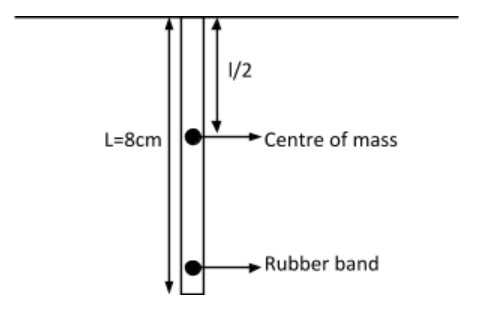
The young’s modulus of a rubber string $8cm$ long and density $1.5kg/{m^3} $is $ 5 \times {10^8}N/{m^2}$, is suspended on the ceiling in a room. The increase in length due to its own weight will be:-
A. $9.6 \times {10^{ - 5}}m$
B. $9.6 \times {10^{ - 11}}m$
C. $9.6 \times {10^{ - 3}}m$
D. $9.6m$
Answer
578.1k+ views
Hint: Concept of relation between young’s modulus and change in length is used.
Formula used: $\Delta l = \dfrac{{{l^2}dg}}{{2y}}$
Complete step by step solution:
Let us consider a rope or rubber band of length $8cm$ as given in the question

As the rope is of length, $l$. Its weight will act downward and there will be increase in its length from centre of mass i.e. $l/2$
We know that the relation between young’s modulus and change in length is given by
$y = \dfrac{F}{A} \times \dfrac{l}{{\Delta l}}$
But here $l \ to l/2$
So, $y = \dfrac{F}{A} \times \dfrac{l}{{2\Delta l}}$
$ \Rightarrow \Delta l = \dfrac{{fl}}{{2AY}}$…………. (i)
Now, density, $d = \dfrac{{Mass}}{{Volume}}$
i.e. $d = \dfrac{M}{V}$
$d = \dfrac{M}{{Al}}$ (as volume$ = $area$ \times $length of rope or rubber band)
$ \Rightarrow A = \dfrac{M}{{dl}}$……….. (II)
Also, force, $F = mg$…………. (III)
Where $g$ is acceleration due to gravity and $g = 10m/{s^2}$
Put (II) and (III) in (I), we get
\[
\Delta l = \dfrac{{mg \times l}}{{2 \times \dfrac{m}{{dl}}}} \times Y \\
\Rightarrow \Delta l = \dfrac{{mgldl}}{{2my}} \\
\Rightarrow \Delta l = \dfrac{{{l^2}dg}}{{2Y}} \\
\]
Given that,
Length of rubber band, $l = 8cm$
$ = 0.08m$
Density, of rubber band, $d = 1.5kg/{m^3}$
Young’s modulus, $Y = 5 \times {10^8}N/{M^2}$
The reaction for increase in length and young’s modulus is as follows,
$\Delta l = \dfrac{{{l^2}dg}}{{2Y}}$
Where
$\Delta l = $Increase in length of rubber band due to its own weight
$d = $Density of rubber band
$g = $Acceleration due to gravity $ = 10m/{s^2}$
$Y = $Young’s modulus of rubber band
$l = $Original length of rubber band.
So, as $\Delta l = \dfrac{{{l^2}dg}}{{2Y}}$
$\Delta l = \dfrac{{\left( {8 \times {{10}^{ - 2}}} \right) \times 1.5 \times 10}}{{2 \times 5 \times {{10}^8}}}$
\[
\Delta l = \dfrac{{64 \times {{10}^{ - 4}} \times 1.5 \times 10}}{{{{10}^9}}} \\
\Delta l = 96 \times {10^{ - 12}} \\
\Delta l = 9.6 \times {10^{ - 11}}m \\
\]
Hence, the correct option is (B).
Note: Before solving the question, we must consider the change in length of the rubber band due to its weight which will cause it to move away from the centre of mass. So, half-length is taken but in density, total length of rubber band is considered as density is due to mass and length of overall rubber band.
Formula used: $\Delta l = \dfrac{{{l^2}dg}}{{2y}}$
Complete step by step solution:
Let us consider a rope or rubber band of length $8cm$ as given in the question

As the rope is of length, $l$. Its weight will act downward and there will be increase in its length from centre of mass i.e. $l/2$
We know that the relation between young’s modulus and change in length is given by
$y = \dfrac{F}{A} \times \dfrac{l}{{\Delta l}}$
But here $l \ to l/2$
So, $y = \dfrac{F}{A} \times \dfrac{l}{{2\Delta l}}$
$ \Rightarrow \Delta l = \dfrac{{fl}}{{2AY}}$…………. (i)
Now, density, $d = \dfrac{{Mass}}{{Volume}}$
i.e. $d = \dfrac{M}{V}$
$d = \dfrac{M}{{Al}}$ (as volume$ = $area$ \times $length of rope or rubber band)
$ \Rightarrow A = \dfrac{M}{{dl}}$……….. (II)
Also, force, $F = mg$…………. (III)
Where $g$ is acceleration due to gravity and $g = 10m/{s^2}$
Put (II) and (III) in (I), we get
\[
\Delta l = \dfrac{{mg \times l}}{{2 \times \dfrac{m}{{dl}}}} \times Y \\
\Rightarrow \Delta l = \dfrac{{mgldl}}{{2my}} \\
\Rightarrow \Delta l = \dfrac{{{l^2}dg}}{{2Y}} \\
\]
Given that,
Length of rubber band, $l = 8cm$
$ = 0.08m$
Density, of rubber band, $d = 1.5kg/{m^3}$
Young’s modulus, $Y = 5 \times {10^8}N/{M^2}$
The reaction for increase in length and young’s modulus is as follows,
$\Delta l = \dfrac{{{l^2}dg}}{{2Y}}$
Where
$\Delta l = $Increase in length of rubber band due to its own weight
$d = $Density of rubber band
$g = $Acceleration due to gravity $ = 10m/{s^2}$
$Y = $Young’s modulus of rubber band
$l = $Original length of rubber band.
So, as $\Delta l = \dfrac{{{l^2}dg}}{{2Y}}$
$\Delta l = \dfrac{{\left( {8 \times {{10}^{ - 2}}} \right) \times 1.5 \times 10}}{{2 \times 5 \times {{10}^8}}}$
\[
\Delta l = \dfrac{{64 \times {{10}^{ - 4}} \times 1.5 \times 10}}{{{{10}^9}}} \\
\Delta l = 96 \times {10^{ - 12}} \\
\Delta l = 9.6 \times {10^{ - 11}}m \\
\]
Hence, the correct option is (B).
Note: Before solving the question, we must consider the change in length of the rubber band due to its weight which will cause it to move away from the centre of mass. So, half-length is taken but in density, total length of rubber band is considered as density is due to mass and length of overall rubber band.
Recently Updated Pages
Master Class 11 Economics: Engaging Questions & Answers for Success

Master Class 11 English: Engaging Questions & Answers for Success

Master Class 11 Social Science: Engaging Questions & Answers for Success

Master Class 11 Biology: Engaging Questions & Answers for Success

Class 11 Question and Answer - Your Ultimate Solutions Guide

Master Class 11 Business Studies: Engaging Questions & Answers for Success

Trending doubts
What is meant by exothermic and endothermic reactions class 11 chemistry CBSE

10 examples of friction in our daily life

One Metric ton is equal to kg A 10000 B 1000 C 100 class 11 physics CBSE

Difference Between Prokaryotic Cells and Eukaryotic Cells

What are Quantum numbers Explain the quantum number class 11 chemistry CBSE

1 Quintal is equal to a 110 kg b 10 kg c 100kg d 1000 class 11 physics CBSE




